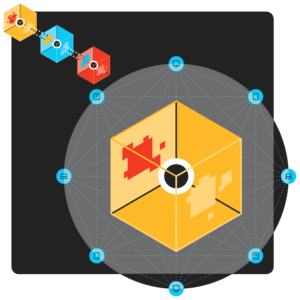Chances are, you’ve heard of blockchain. It’s the world’s most popular way to buy, sell, and trade cryptocurrency. Whether you’re a nocoiner or bitcoin maximalist, you can’t deny that blockchain is sweeping the globe.
Hollywood is embracing it. Video game companies are exploring its usage. So perhaps it’s no surprise that blockchain usage is already alive and well in the manufacturing industry.
But before we dive into the details of that, let’s start with a basic introduction to the concept.
What is blockchain?
In high level terms, blockchain is a distributed database. A copy of the database is stored on all nodes participating in a peer-to-peer network. Using secure algorithms, data transactions stored in blocks are verified by the nodes in the network before being added to the database, or “chain.”
Each block in the chain contains data, the digital fingerprint of the block, and the digital fingerprint of the previous block. If data in an existing block stored on a node is modified, the digital fingerprint of that block will change, breaking the integrity of the chain.
The remaining nodes in the network will then no longer trust that copy of the database. This secures and helps prevent alteration to existing data stored in the chain.
Advances in blockchain technology
Advances in blockchain technology have led to the ability to store logic programs, or “smart contracts,” inside blocks that can be used to allow data transactions to automatically happen when specific conditions are met.
A basic example of this could be that payment to the seller in an online marketplace is automatically transmitted when the item sold is marked as delivered to the buyer by the shipping service. The underlying security with blockchain technology ensures the smart contract is verified by all nodes and cannot be altered.
How manufacturers are using blockchain
Blockchain technology is being used by manufacturers to expand, streamline, and better secure their products and procedures.
Supply chain tracking
Baia’s Wine, located in Western Georgia, uses a blockchain based supply chain solution to provide better accuracy, auditing, and help expose any counterfeit bottles of wine sold on the open market. Secure QR codes are added to the wine bottles, which are tied to data stored on a blockchain to provide detailed supply chain tracking.
DHL and Accenture are working together to develop and use blockchain technology to track pharmaceuticals from the point of origin to the end consumer to prevent errors and tampering.
Expanding physical products to digital
TOPPS is using blockchain technology to produce digital representations of baseball cards in the form of non-fungible tokens, or “NFTs.” Non-fungible tokens stored on a blockchain are unique.
Providing digital representations of baseball cards as NFTs allows digital card collectors to prove ownership and know the scarcity of each card produced. Collectors can assign perceived value to the digital cards to buy, sell, and trade.
This concept is quite a shift from the days of opening wax packs and hoping the bubble gum didn’t stain your card. It will be interesting to see if, over time, physical baseball cards are no longer produced—being replaced completely by NFTs.
These examples represent a tiny fraction of blockchain adoption and use cases. Blockchain technology is being evaluated and used across multiple sectors to enhance, provide better security for, and expand processes and products. Only time will tell what the future holds as this technology continues to advance with new use case ideas being born.
